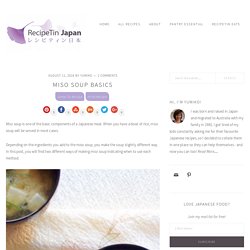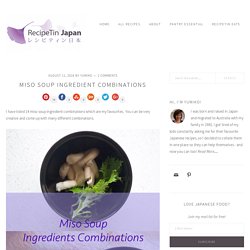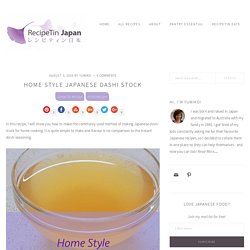

Barbecue Eggplant. Hello!

I am happy to see you again. I will update this blog once a week. Adam Liaw's black pepper teriyaki wings, and Japanese green avocado salad. Much like the country itself, Japanese cuisine always seems to be shrouded in some kind of mystical secret code.

Hefty volumes are written on the many customs and levels of etiquette required to navigate Japanese dining culture. We hear stories of sushi chefs training for a decade just to learn how to put a slice of fish on a mound of rice, and artisans devoting their entire lives to making a bowl of noodles. It's a shame that our tendency to mythologise Japanese cuisine discourages so many of us from cooking it, and in doing so missing out on one of the easiest, fastest and healthiest cuisines on Earth.
Japanese food isn't difficult or complicated. Miso Soup Basics. Miso soup is one of the basic components of a Japanese meal.

When you have a bowl of rice, miso soup will be served in most cases. Depending on the ingredients you add to the miso soup, you make the soup slightly different way. In this post, you will find two different ways of making miso soup indicating when to use each method. Miso soup is misoshiru (味噌汁) in Japanese and is a generic name for Japanese soup made with dashi (出汁) stock and miso (味噌). Typically, you will have a couple of ingredients cooked in the soup but there are no rules as to how many ingredients and what kind of ingredients must be in the soup. Miso is a traditional Japanese seasoning made from soya beans which has undergone fermentation and looks like thick paste. Miso Soup Ingredient Combinations. I have listed 14 miso soup ingredient combinations which are my favourites.

You can be very creative and come up with many different combinations. In the post, Miso Soup Basics, I introduced three main types of Miso. They are shiro-miso (白味噌), aka-miso (赤味噌) and awase-miso (合わせ味噌). The professional Japanese chefs might use a particular type of miso for certain combinations of ingredients. But for home cooking, especially if you use aware-miso which are the common miso available at Asian grocery stores and even supermarkets, any combination of ingredients would be fine, in my view. Miso Soup Basics. Home Style Japanese Dashi Stock. In this recipe, I will show you how to make the commonly used method of making Japanese dashi stock for home cooking.

It is quite simple to make and flavour is no comparison to the instant dashi seasoning. Depending on the dishes you make, you use different kinds of dashi (出汁) stock as seen in the list below. Main varieties of Japanese dashi stock Awase-dashi (合わせ出汁) – made from katsuobushi (鰹節, dried bonito flakes) and konbu (dried kelp)Katsuo-dashi (鰹出汁) – made from katsuobushi (鰹節, dried bonito flakes) onlyKonbu-dashi (昆布出汁) – made from konbu (昆布, dried kelp)Niboshi-dashi (煮干し出汁) – made from niboshi (煮干し, dried small sardines/anchovies)Shiitake-dash (椎茸出汁) – made from dried shiitake (椎茸) mushrooms In the case of awase-dashi and katsuo-dashi, you can get dash stock twice from the same ingredients.
Different types of dashi stocks. I like awase-dashi the most as it has the best flavour. About Katsuobushi Dried bonito flakes are shavings of dried bonito. About Konbu. Japanese Salmon Mirin-zuke (Mirin Marinade) Simply marinating salmon with mirin (味醂), soy sauce and sugar will transform the salmon to a different level.

8 Creative Ways to Cook With Super-Healthy Miso. There’s much ado about miso lately.

It’s a major food trend for 2016, and we’re pretty darn pleased. Though you probably have an idea what miso is from trying miso soup, the actual ingredient — miso paste — is made from fermented soybeans (though other legumes, such as chickpeas and even grains, like barley, may be used as well). And it’s time to think beyond just upgrading your ramen, ladies: From buddha bowls to savory sauces, miso has a lot of other applications besides its popular spot as a savory, antioxidant-packed umami staple.
We asked some leading nutritionists to tell us their favorite ways to use this flavor-packed paste at home. 1. 2. 3. 4. 5. 6. 7. 8. Miso Broiled Salmon. This miso broiled salmon with fresh ginger, scallions and a sweet, savory miso glaze is so easy to make and it tastes like something you’d order at a fancy restaurant!

This recipe was originally posted in 2010, but I am reposting it because it’s been updated and the photos are new. BBQ Pork Belly. Print RecipeJump To Recipe As we started to feel the chilly autumn air in the evening I realized that the end of summer is quickly approaching in the Northern Hemisphere.

I would like to share a few more of my BBQ recipes before the summer ends. Today’s BBQ marinade is really easy to make and tasty so I make this BBQ Pork Belly pretty much all year around. For barbequing pork belly, I highly recommend to use an outdoor grill so that the extra fat will melt off and the finished product won’t be as oily. We used juicy and soft pork belly meat but you can replace it with other meat such as beef or chicken to enjoy with the marinade. By the way, I would like to thank you for the kind comments for my son’s first day of 1st grade. Hope everyone will have a great week and enjoy the remainder of the summer! Chicken Meatballs 豆腐ハンバーグ. Print RecipeJump To Recipe These Teriyaki Chicken Meatballs are soft and fluffy, and my kids love them!

What’s the secret ingredient to make them so fluffy? It’s tofu! Actually in Japan, we call this dish Tofu Hambagu (豆腐ハンバーグ) – “hambagu” as in Japanese Hamburger Steak. However, most of tofu hambagu are made with tofu AND ground meat (usually chicken, sometimes combination of beef & pork). Why tofu? And please note that the meat acts as binding agent here. Pressure Cooker Short Ribs 牛バラ肉と大根煮(圧力鍋) Print RecipeJump To Recipe The weather has been pretty cold these days and I’ve been longing for nice comfort food. Today I’m going to share one of my favorite pressure cooker recipes – Pressure Cooker Short Ribs. I’ve been in love with my Instant Pot ever since I started using it. It’s really a timesaver and I highly recommend it for busy moms.
So far on my blog, I’ve shared Pressure Cooker Anko (Red Bean Paste), Pressure Cooker Pork Belly, and Slow Cooker Chicken Wings. Instant Pot has both slow cooker and pressure cooker functions, at first I used slow cooker function but these days I’m only using it as a pressure cooker. Yaki Onigiri (Grilled Rice Ball) 焼きおにぎり. Print RecipeJump To Recipe Today I’m going to share Yaki Onigiri (焼きおにぎり) recipe. Yaki means “grilled” in Japanese (you probably heard enough from my blog – Teriyaki, Yakisoba, Yakiniku, Yakitori, etc), and onigiri means “rice ball.”
Unagi Don (Unadon) 鰻丼. Print RecipeJump To Recipe In my last post, I talked about the delicious char-grilled unagi (eel) I had at an unagi specialty restaurant in Yokohama during my Japan trip. For those of you who are not as familiar with Japanese cuisine, you might be thinking we are barbaric eaters! Well, to be honest with you, I grew up eating eels without feeling it was a foreign ingredient. When unagi was served, it always looked like a typical fish fillet to me… don’t you agree as well looking at the picture above? I was surprised when I found out what eels actually looked like in an aquarium at a young age. Unagi sushi are pretty popular and available at most sushi restaurants, but the satisfaction from eating just-grilled unagi on top of warm rice is completely different and can not be compared. Sometimes my local Japanese supermarket sells imported unagi from Japan. Most Japanese don’t buy a live eel to cook at home.
This style of cooking is called kabayaki (蒲焼), similar to Teriyaki. Notes.